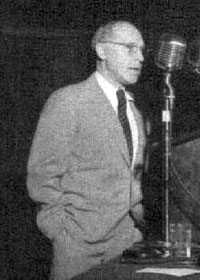The gene is the fundamental building block of life. Genes determine how cells function and what traits are passed from one generation to the next. Little was understood about them when they were discovered in the late 1800s. However, the research of one Texas scientist and Nobel Prize winner, Dr. Hermann Muller, led to major breakthroughs in understanding the nature of genes.

In 1915, Muller was offered a position at Rice University in Houston as a biology professor and researcher. Rice had only been founded three years before, and its leaders were anxious to establish its reputation as a center for scientific research. He continued to focus his research on the genetics of flies and increasingly looked at genetic mutations. However, the lack of available lab assistants during World War I greatly limited his abilities to continue his research. He left Rice and teamed up with his former mentor at Columbia University. As part of the continuation of their work, Muller was able to determine by 1920 that the size of wings of flies was determined genetically, a major breakthrough in understanding genetics.
He returned to Texas as a professor and researcher at the University of Texas in the fall of 1920. While at UT, he conducted some of his most important work regarding genetics. In 1923, he began using x-ray radiation in his genetic studies. Muller was becoming increasingly renowned among scientists, and he was invited to serve as a special professor in physiology at the University of Chicago in 1925 before resuming his work in Austin. By 1926, Muller was able to conclusively demonstrate that x-rays caused lethal mutations in flies. The discovery cemented his reputation in the scientific community. By 1928, he was also able to show that high levels of radiation also caused fatal damage in other types of insects and in plants such as corn and strongly suggested that radiation also posed a danger to human beings. He came to write dozens of scientific articles outlining his many findings.
Up to that time, very little was understood about the effects of radiation on animal tissues and cells. Scientists experimenting with radiation had reported strange burns and increased cancer rates for years. While the words “radiation” and “mutations” became embedded in the imaginations of many science fiction novelists, comic book creators, and the general public in the years to come, Muller’s experiments conclusively showed the destructive effects of high levels of x-rays on cells. The x-ray was quickly becoming an indispensable tool in medical diagnostics in the 1920s, but Muller’s discovery demonstrated the need to limit the power of x-ray scans and exposure.
Muller left the University of Texas in 1932 and spent the next several years working in labs and teaching at various universities in the United States and Europe. In 1942 and 1943, he worked once again at the University of Chicago where he briefly worked on aspects of the Manhattan Project, America’s top-secret effort to produce an atomic bomb during World War II.
In 1945, Muller accepted a position as professor of zoology at Indiana University. In 1946, he was given the Nobel Prize in Medicine for his work in genetics, the most respected award in science. In his acceptance speech, Muller warned of the dangers of radiation, suggesting that there may not be a safe level of x-rays or other types of high-energy radiation. He spent the last years of his life warning about the dangers of nuclear war and radiation poisoning, calling for an end to the nuclear arms race of the 1950s and 1960s and calling for an end to nuclear testing.
Scientists not only impact the world with their own discoveries but also with the students they teach. Muller had a tremendous influence on his students, helping to train a number of important scientists. Dr. Wilson Stone, a longtime professor at the University of Texas, studied under Muller and continued his work on radiation and demonstrated how ultraviolet radiation affected bacteria and was later a consultant for the Atomic Energy Commission. Muller also helped train Dr. George Snell, who shared the 1980 Nobel Prize in Medicine for his work that showed the link between genes and successful organ transplants. Famed astronomer Carl Sagan also studied under Muller, working in one of his labs while still an undergraduate. Muller died at his home in Indianapolis in 1967 at the age of 76.

